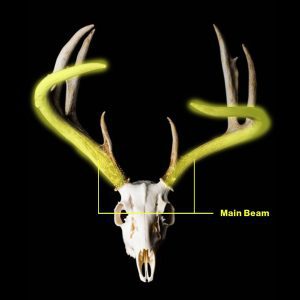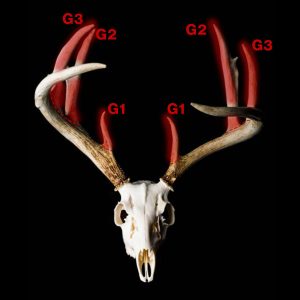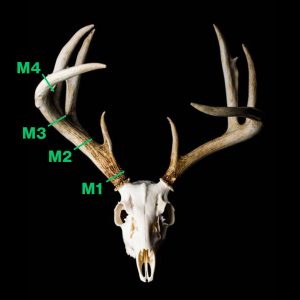If you have ever taken a buck with a monster set of antlers, you may have wondered how big its antlers are and how they score the rack. Officials use an antler scoring system to score and compare a bucks’ antlers. There are multiple respected antler scoring systems used in the field, including Pope and Young, Safari Club International, and Boone and Crockett.
Before you score your deer, make sure you have properly gutted it (learn how to gut a deer here) and tagged it- check out our article explaining the deer tagging process! Or, check out our deer tracking tips!
Why Use the Antler Scoring System?
Using the antler scoring system is just like weighing a deer, but for its antlers. If you know the score of the deer’s antlers, you are able to describe it without showing a photograph. All antlers are different, so saying it weighed 200lbs doesn’t always give a good representation of the antler size, and saying it was an 8 pointer doesn’t either. The antler scoring system is also important to use if you have taken a buck that scores above average. You can take pride in the score, knowing you put all the hard work into successfully tagging a trophy.
Antler Scoring System Terminology
Before we jump into explaining the antler scoring system, let’s break down the antler scoring system terminology. It is important to understand the system’s commonly used words.
Point –
A point is just as it sounds. Any point coming off the antlers, but it must be at least 1 inch long to be classified as a point.
Abnormal Point –
Any points coming off the antlers in a non-typical location are called abnormal points. Abnormal points could be coming off a normal point, the side or bottom of the main beam, or any point outside the normal pattern.
Burr –
A burr is located at the base of a buck’s antler. It flattens at the base of the skull.
Beam –
A beam is the main point coming from the burr to the tip
G –
When naming antler points, the letter G is used. G1 refers to the 1st antler point, G2 refers to the second, and so on.
H –
The circumference of an antler is referred to with the letter H.
How To Use the Antler Scoring System?
Instead of tracking down an antler scoring system expert, learn how to score antlers yourself. You will need a flexible tape measure, pen and paper, and a yardstick (optional). Decide if you are going to score the antlers as typical or non-typical. All measurements are made to the nearest 8th of an inch. Let’s break down the antler scoring system into five easy steps.
Step One: Measure the inside spread of the antlers.

This is where a yardstick is the easiest, but you can also use a tape measure. Stand the rack up straight and measure the widest point between the beams. Write this measurement down.
Step Two: Measure the main beams.

Start with the tape measure at the burr edge. Measure all the way up to the tip of the beam on the outside. Write this measurement down and continue with the other side of the rack.
Step Three: Measure each point

Starting with the G1 point, write down the measurement for each point. If you are measuring a 10- pint buck you have 4 measurements of each side because the fifth point is the tip of the beam.
Step Four: Measure the mass

Measure the thinnest place between each point, starting between the burr and G1. You will stop once you have measured between G3 and G4. If the buck does not have a G4 point, you will measure between G3 and the tip of the beam. Repeat on the other antler.
Step Five: Add measurements
The final step is to add all measurements together. This will give you the final gross score.
Check out our tips to have more success in hunting blinds! Or, read about shed hunting here!


